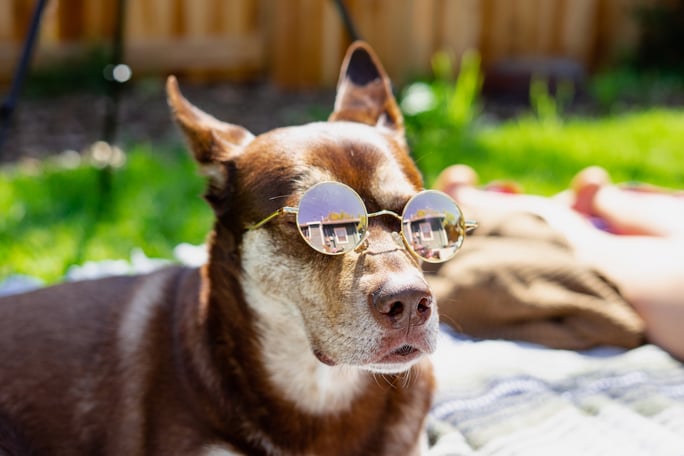Protecting Your Pets from Sunburn this Summer
Updated on: April 12, 2023 | Author: Starwood Pet Travel

By now we all know how important it is to protect our skin from over-exposure to the sun. Those ultraviolet rays can burn our skin, causing problems from redness and pain to wrinkles and even cancer. But did you know your pets can get sunburned, too?
They can also suffer the same serious long-term damage – not wrinkles or age spots, of course, but skin cancer is a serious risk.
In fact, skin cancer is the #1 cancer in dogs. Cats, too, can develop skin cancer from too much sun. Gives you paws for thought, doesn’t it? Let’s keep our dear dogs and cats safe this summer! Here’s what you need to know.
Fur protects, but not completely
Your pet’s fur is a natural barrier between their skin and the sun’s UV rays. That would be great, except some breeds of dogs and cats have very short or virtually non-existent fur, putting them at greater risk. White or light-colored fur offers less protection, too. That may seem odd since light colors generally reflect heat, but most animals with pale fur also have white or pale pink skin, which makes them more vulnerable.
Cats at greatest risk include Sphynx, Peterbald, and other hairless breeds as well as Cornish Rex and Devon Rex. These kitties have fur of a sort, but it doesn’t offer any real protection from the sun. When it comes to dogs, you may be surprised to see who’s on the high-risk list:
- American Staffordshire Terrier (and Pitbull)
- Boxer
- Chinese Crested
- Dalmatian
- Golden Labrador Retriever
- Golden Retriever
- Greyhound
- Weimaraner
- Whippet
- White German shepherd
So think like a human about sunburn for pets – the lighter, the riskier. Fur traits aside, though, no dog or cat is completely covered with protective fur. Those exposed areas can burn in as little as 15-20 minutes under the unrelenting sun. Obvious spots include the nose and around the mouth and eyes, but sunburn can easily occur on any of these extra-sensitive areas where fur is very short or sparse:
- Belly and armpits (dogs and cats who love to lie on their backs in the sun are at risk, but UV rays also reflect upward from surfaces such as sand and concrete, increasing the risk for every pet)
- The inguinal area (between your dog’s hind legs)
- Snout
- Ears (inside, too, if your pet’s ears stand erect)
Animals prone to dermatitis or allergies and those dealing with chemotherapy or hormonal issues are at greater risk as well.
What can you do to protect your pet?
Sunburn awareness is a great start, but taking the following steps will guard that fun in the sun doesn’t turn into an unhappy experience for your cat or dog.
Apply sunscreen. Just as for humans, this is the first line of defense against sunburn. There are products specially formulated for pets, although you can also use gentle “people” products made for babies, with SPF 30-50. Bear in mind that whatever you put on, your dear dog or cat is likely to lick off, at least to some degree. This makes it imperative that you read the label before using any product because you don’t want to trade one problem for another.
- The zinc in zinc oxide is toxic to dogs, and many sunscreen products contain this popular ingredient. Snout Soother is an alternative for dogs that contains natural SPF.
- Octyl salicylate and other chemicals can be toxic to cats.
Your vet can recommend other options, especially for cats since cat-appropriate sunscreen can be hard to find. Whatever you use, apply the sunscreen to all the vulnerable areas, and reapply as recommended, especially if your dog goes swimming.
Do not shave your pet. You may think a “lion cut” looks adorable, but you’re robbing your pooch or kitty of their sun protection. Instead, use an undercoat-thinning brush to lighten your pet's coat.
Provide shade. This is crucial no matter where you are. Animals can suffer heatstroke as well as sunburn, so shade offers two critical benefits. Other cooling options include a wading pool, a swim in a nearby lake or river, or a hose-off on the lawn. Always make sure your pet has water to stay hydrated, whether you’re at home or on the go.
Cover up your pet. Just as a sweater can keep your dog warm and dry in winter, a lightweight, light-colored cover-up can protect them from the sun. They can also look stylish while protecting their skin.
Cover your window. UV rays easily penetrate glass, but a strip of clear anti-UV film on the window will make your cat’s favorite spot a safer place to sack out in the sun.
Limit exposure to avoid sunburn
A final (and somewhat obvious) way to protect your pet from sunburn, is to limit their exposure to the sun. Preventing sunburn is not difficult, and it can save your cat or dog from pain and suffering.
Subscribe to the Blog
Enjoy our content? Get them sent to your inbox!
Subscribe Now!

